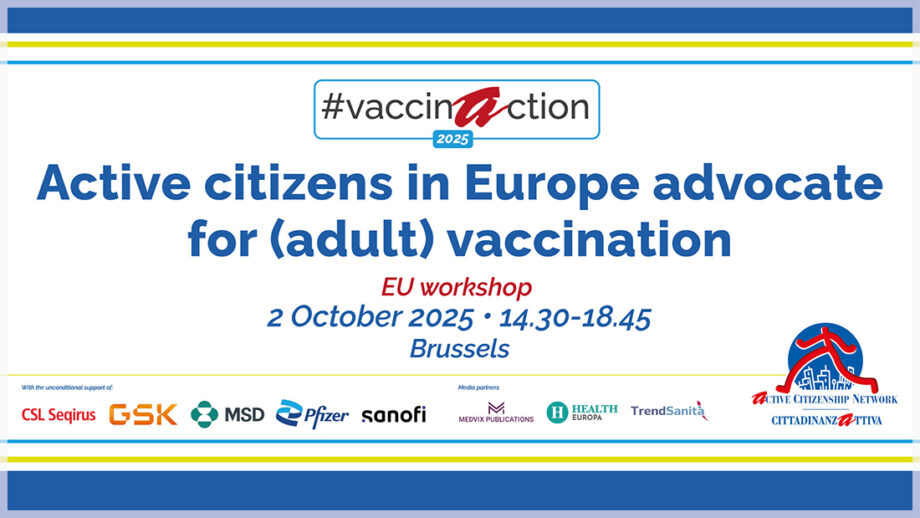Vaccination is not only a strategy to reduce the risk of infectious diseases: it is increasingly recognized as a form of cardiovascular prevention. In recent years, growing scientific evidence has shown how respiratory and other infectious diseases can directly affect the health of the heart and blood vessels, increasing the risk of serious cardiovascular events. This opens up a new perspective for Italian and European health policies: integrating vaccination into cardiovascular prevention pathways.
These topics were at the center of a discussion with Marco Del Riccio, medical doctor specializing in Hygiene and Preventive Medicine, currently serving as Assistant Professor at the Department of Health Sciences, University of Florence, interviewed by TrendSanità during the European workshop “Active Citizens in Europe Advocate for (adult) Vaccination”, held on 2 October 2025 as part of the VaccinAction2025 project and organized by Cittadinanzattiva-Active Citizenship Network.
Infections increase cardiovascular risk, thus opening a new perspective for health policies: integrating vaccination into heart prevention pathways
The event brought together representatives from civic and patient associations, healthcare professionals, academics and advocacy experts to discuss the role of vaccination strategies in the management of chronic diseases — particularly cardiovascular diseases — and to promote awareness-raising actions among policy makers in order to recognise vaccination as a pillar of preventive healthcare.
The link between infectious diseases and cardiovascular health

“Regarding the evidence, it is interesting to see how it has accumulated in a bidirectional sense concerning the relationship between cardiovascular diseases and the prevention of infectious diseases [Ecarnot et al, 2025]”, says Dr Del Riccio.
This relationship is not an intuitive one: “People sometimes wonder why preventing infectious diseases should matter for preventing cardiovascular diseases. It’s important to focus on this point because it’s often not self-evident.”
The mechanism is twofold. On one hand, there are direct effects: some infections can damage the blood vessel walls. On the other, there are indirect mechanisms, , such as systemic inflammation and metabolic stress induced by respiratory illnesses. “Think of influenza or herpes zoster—diseases that can significantly affect our cardiovascular system,” he explains.
Infections can damage blood vessels both directly and through systemic inflammation
An infection can force the body into high energy expenditure, putting pressure on the cardiovascular system. “If we imagine a 70-year-old person with heart failure, evidence shows that after influenza, the risk of acute myocardial infarction increases up to around sixfold in the first weeks following infection [Kwong et al, 2018]. In the case of herpes zoster, the risk of stroke increases mainly during the first weeks after the onset of the rash — with an early peak — and gradually decreases over time [Langan et al, 2014].”
These data highlight a key concept: preventing infections also means protecting the heart.
Scientific evidence: vaccines as cardiovascular protection
An innovative concept that paves the way for greater integration of vaccinations into prevention programs.
The hypothesis that preventing infectious diseases also reduces cardiovascular risk is not just theoretical. “There is strong evidence that vaccines such as the one against herpes zoster reduce the risk of stroke and other major cardiovascular events [Ecarnot et al, 2025]”, confirms the expert.

The same applies to the influenza vaccine, which, in addition to reducing hospitalization and mortality from flu, also shows positive effects on cardiovascular events: “Data confirm that influenza vaccination is highly beneficial for preventing hospitalizations due to cardiovascular causes. This is an important result.”
This evidence led the European Society of Cardiology (ESC) to publish an official Consensus Statement titled “Vaccination as a new form of cardiovascular prevention.” “This is an innovative concept that paves the way for greater integration of vaccinations into prevention programmes, as we recently reiterated in our response to the public consultation launched by the European Commission on the EU Cardiovascular Health Plan,” comments Mariano Votta, Director of Active Citizenship Network.
Targets and vaccination strategies
Vaccination plays a central role, but defining the right target groups is not simple. “The debate always focuses on targets: should they be based on age or risk groups? The choice depends on the context and public health objectives but approaches that combine both criteria are usually the most effective” observes Del Riccio. Both factors must be considered.
“Age is a practical organizational criterion to identify target populations, but it has limited biological and clinical significance. Therefore, age alone is not sufficient to define vaccination priorities: it is essential to also include at-risk groups, regardless of age, such as people with chronic cardiovascular, respiratory, or oncological diseases.”
Age alone is not enough to define vaccination priorities: it is also necessary to include at-risk groups
These groups benefit significantly from vaccination—not only because they reduce infection risk but also because they can avoid delays in treatment for their conditions. “An oncology patient who contracts an infection may have treatments postponed, with significant consequences.”
Italy and Europe: gaps in vaccination coverage
Discussing organizational models without data means navigating in the dark. It is impossible to act on what is not measured. “That’s the approach we’re also adopting within the Adult Immunization Board, which focuses on defining priorities and indicators, synthesizing evidence, and promoting shared standards to help decision-makers measure more effectively and act accordingly” notes Del Riccio.
Vaccination is a cross-cutting tool across all disciplines and should be part of integrated prevention, treatment, care, and rehabilitation pathways
A useful example is influenza vaccination—a long-established and widely recommended practice with fairly uniform monitoring across the European Union, albeit with country-specific differences. However, ECDC data show that almost no European country meets the WHO target of vaccinating three out of four people aged over 60 or 65, highlighting how even in well-structured programs, significant coverage gaps remain.
During the 2021 influenza season, in the midst of the COVID-19 pandemic, Europe saw an increase in vaccination coverage. This growth was linked to fears of co-infection and the desire to avoid hospital overload. However, it was an exceptional event: in subsequent months, coverage levels returned to pre-pandemic values [Del Riccio et al, 2025].
Research and policy perspectives
According to Del Riccio, improving the implementation of existing vaccination strategies is crucial: “We have products that work, even with some known limitations; we have identified at-risk populations, but the implementation phase is lacking. Finding better strategies to apply existing knowledge and tools is a fundamental step to make organizational models and public health interventions more effective. We need a multi-stakeholder collaboration involving professionals, media, citizens, and patients: without mutual trust, achieving tangible results will be difficult.”
Only collaboration among professionals, media, citizens, and patients can build trust and achieve tangible results
Implementation does not only concern community healthcare, and the perception of vaccination risk also affects healthcare professionals. “It’s not a matter of lack of knowledge, but rather of being immersed in daily routines that make one focus on their specific field. That’s why it’s essential to convey that preventing infectious diseases through vaccination is a cross-cutting tool, to be integrated into all care, assistance, and rehabilitation pathways.”
Vaccination as integrated prevention
The link between preventing infectious diseases and cardiovascular health is now well established. Targeted vaccinations, coverage monitoring, innovative organizational strategies, and the use of digital health can transform the way we approach prevention.
“Vaccination is a cross-disciplinary tool that should be part of integrated pathways of prevention, therapy, care, and rehabilitation,” concludes Marco Del Riccio.
The message is clear: integrating vaccination into cardiovascular prevention and care pathways is a priority—not only for individual health but also to reduce the burden of chronic diseases on healthcare systems in Italy and across Europe. This is also a shared goal of the VaccinAction2025 project, of which the October 2nd workshop represented a moment of exchange and collaboration between healthcare professionals, scientific community and active citizens.
References
- Del Riccio M, Guida A, Boudewijns B, et al. A Missed Opportunity? Exploring Changes in Influenza Vaccination Coverage During the COVID-19 Pandemic: Data From 12 Countries Worldwide. Influenza Other Respir Viruses. 2025;19(1):e70057
- Ecarnot F, Amuthavalli Thiyagarajan J, Barbagallo M, et al. Infectious diseases, cardio-cerebrovascular health and vaccines: pathways to prevention. Aging Clin Exp Res. 2025;37(1):80
- Heidecker B, Libby P, Vassiliou VS, et al. Vaccination as a new form of cardiovascular prevention: a European Society of Cardiology clinical consensus statement. Eur Heart J. 2025;46(36):3518-3531
- Kwong JC, Schwartz KL, Campitelli MA, et al. Acute Myocardial Infarction after Laboratory-Confirmed Influenza Infection. N Engl J Med. 2018;378(4):345-353
- Langan SM, Minassian C, Smeeth L, Thomas SL. Risk of stroke following herpes zoster: a self-controlled case-series study. Clin Infect Dis. 2014;58(11):1497-1503






